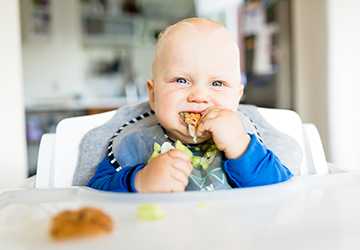Baby-led weaning is an approach to introducing solid foods that allow babies to feed themselves from the start. This method is gaining popularity among modern parents due to its numerous benefits in promoting infant independence and healthy eating habits. This article introduces baby-led weaning, providing the basics of baby-led weaning and a comprehensive baby-led weaning guide.

Understanding Baby-led Weaning
Baby-led weaning is a developmental approach that encourages babies to self-feed finger foods instead of being spoon-fed purees by parents. This method is not just about introducing solid foods but also about allowing your baby to explore textures, tastes, and the experience of eating.
The Right Time to Start:
● The ideal time to begin baby-led weaning is when your baby shows signs of readiness, usually around six months old. These signs include being able to sit up unaided, showing interest in food, and the ability to grasp objects and bring them to their mouth.
Health and Safety Considerations:
● Safety is paramount in baby-led weaning. Always supervise meals and be aware of the size and shape of the foods offered to avoid choking hazards.
● Start with soft, easily graspable foods that are big enough for your baby to hold but soft enough to mash with their gums. Examples include steamed vegetables, ripe fruits, and small pieces of soft-cooked meat.
The Benefits of Baby-led Weaning
This approach offers several advantages for the baby's development and family dynamics.
Promotes Motor Development and Chewing Skills:
Baby-led weaning encourages the development of motor skills and hand-eye coordination as babies learn to grasp and manipulate food.
It also promotes better chewing skills and oral motor development since the baby learns to manage different food textures from the outset.
Fosters Independence and Confidence:
Allowing babies to control their food intake can foster a sense of independence and confidence. They learn to self-regulate, which can lead to healthier eating patterns in the future.
Practical Tips for Implementing Baby-led Weaning
Implementing baby-led weaning can be a delightful yet messy journey. Here are some practical tips to make the process smoother.
Embrace the Mess:
● Baby-led weaning can be messy as babies learn to eat. Embrace this as part of the learning process. Bibs, splash mats, and easy-to-clean high chairs can make cleanup easier.
Family Meals:
● Incorporate baby-led weaning into family meal times. Eating together encourages babies to try new foods and learn by mimicking family members.
● Expanding our understanding of baby-led weaning involves looking at additional aspects contributing to its growing popularity among parents. This part of the article aims to provide further insights into this feeding approach, focusing on the basics of baby-led weaning, an introduction to baby-led weaning, and a detailed baby-led weaning guide.
Exploring the Nutritional Implications of Baby-led Weaning
One crucial aspect of baby-led weaning is its impact on the baby's nutritional intake and overall health.
Diversifying the Diet:
● In baby-led weaning, the emphasis is on offering a variety of foods. This exposure to different flavours and textures from the beginning can encourage babies to develop a more diverse palate, reducing the likelihood of picky eating habits later on.
● Parents should aim to include iron-rich foods, as iron deficiency can concern infants. Options like soft meatballs, cooked beans, or iron-fortified cereals are excellent choices.
Monitoring Nutritional Intake:
● While baby-led weaning promotes independence, parents should closely monitor their baby's intake to ensure they receive adequate nutrition. This includes observing their growth and development patterns and consulting with a paediatrician if there are concerns.
● Balancing self-fed meals with spoon-feeding can sometimes be necessary, primarily to ensure the baby receives enough of certain nutrients like iron and vitamin D.

Cultural and Lifestyle Considerations in Baby-led Weaning
Baby-led weaning is not just a feeding method; cultural and lifestyle factors influence it.
Cultural Influences:
● Different cultures have varying approaches to introducing solids. Baby-led weaning can be adapted to include traditional family foods, making it an inclusive method that respects cultural dietary practices.
● Sharing culturally diverse foods can enrich the baby's eating experience and appreciation for different cuisines from an early age.
Adapting to Family Lifestyles:
● For families who travel frequently or have busy schedules, baby-led weaning can be adapted to fit their lifestyle. Portable, easy-to-handle foods like banana pieces, avocado slices, or steamed carrot sticks can be convenient options.
● The flexibility of baby-led weaning means it can be integrated into various family routines, making meal times less stressful and more enjoyable for everyone involved.
Navigating Common Challenges in Baby-led Weaning
While baby-led weaning offers many benefits, parents often face challenges that can be navigated with the proper knowledge and strategies.
Dealing with Gagging and Mess:
● Gagging is a normal part of learning to eat and is often confused with choking. Understanding the difference is crucial in baby-led weaning. Gagging is a safety reflex that helps prevent choking, whereas choking is a silent and dangerous airway blockage.
● Embracing the mess that comes with baby-led weaning is part of the process. Easy-to-clean high chairs, floor mats, and bibs with food catchers can make meal times less stressful.
Ensuring Balanced Nutrition:
● While baby-led weaning allows the baby to explore and enjoy a variety of foods, ensuring they receive a balanced diet is essential. Parents should offer foods rich in iron, protein, calcium, and other necessary nutrients.
● Consulting with a paediatrician or a nutritionist can guide you on maintaining a balanced diet and ensuring the baby's growth and needs are met.
Conclusion
Baby-led weaning is a rewarding journey that lays the foundation for healthy eating habits and fosters a positive relationship with food. By understanding the basics of baby-led weaning and following this guide, parents can give their babies a strong start in their culinary exploration. As with any significant milestone in a baby's life, patience, persistence, and love are vital to making the experience enjoyable and beneficial for the baby and the parents.


